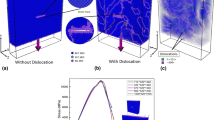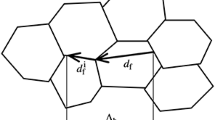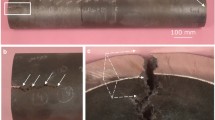Abstract
An investigation of brittle fracture in extruded beryllium tubes is described following an unusual brittle fracture of a beryllium clad fuel element at plastic strain of about 0.15% produced by differential thermal contraction. A characteristic spiral form of fracture is shown to be caused by cleavage failure of the highly textured tube along (1120) planes under biaxial stress generated by the contraction of the can onto the pellets, but the crystallography of the fracture does not reveal cause of the unexpectedly low plasticity.
Mechanical testing of the tubes revealed circumferential ductilities of about l% which is in agreement with values expected from the high degree of texture of the tube; axial ductilities were anomalously very low at about 0.2%. Less textured materials gave longitudinal ductilities of several percent, expected from the texture.
Thin filaments cut from the walls of double extruded material gave much greater elongations than the whole tube, showing that the material was not inherently brittle and tests on filaments of varying arc widths suggested that progressively increasing the width of curved specimens was accompanied by decreasing ductility. Some evidence is presented supporting the theory that the brittleness is caused by premature failure following the action of a secondary deformation process activated by transverse loop stress arising from the plastic anisotropy of the material and the tube curvature. It is suggested that this process is twinning which is known to lead to non-ductile failure.
Résumé
On décrit une investigation de la fragilité des tubes en béryllium fués à la suite d'une rupture fragile extraordinaire d'un é1ément combustible gainé de béryllium avec une déformation permanente d'environ 0,15% produite par une contraction thermique différentielle. Il est démontré qu' une rupture charactéristique en spirale est provoquée par clivage du tube, qui a une texture bien développée, le long des plans (11bar20) sous une contrainte biaxe générée par la contraction de la gaine sur les pastilles, mais la cristallographie de la rupture ne révèle pas la cause de la valeur si faible de la plasticité.
Un essai mécanique des tubes a décelé une ductilité circonférentielle d' environ 1%, qui s' accorde avec les valeurs qu'on attendrait ca vue du haut degré de texture des tubes; la ductilité axiale était anormalement très faible à environ 0, 2%. Les matériaux avec moins de texture oat donné des ductilités de quelques pourcent, qu'on pouvait atteadre de la texture.
Des filaments minces coupés des parois de matériau doublement filé ont donné des allongements bien plus grands que la tube entère, ce qui montre que le matériau n' était pas fragile de nature, et des essais sur des filaments avec des largeurs d' arc différentes ont indiqué qu' une augmentation progressive de la largeur des echantillons courbes est accompaguée d' une reduction de la ductilité. On présente des preuves a l' appui de la théorie que la fragilité est due à une rupture prématurée à la suite d' un phénomene de déformation secondaire, activé par une contrainte circonférentielle résultant de l' anisotropie plastique du matériau et de la courbure des tubes. On suggàre que ce phénomène est celui du maclage, qui, 1'on sait, conduit à la rupture non-ductile.
Zusammenfassung
Eine Untersuchung des Sprödigkeitsverhaltens von stranggepressten Berylliumrohrea im Anschluss an einea ungewöhnlichen Sprödbruch eines berylliumumhullten Breanstoffelements bei einer bleibenden Verformung von ungefähr 0,15% als Folge von unterschiedlicher Wärmeschrumpfung wird heschrieben. Es wird gezeigt, dass ein charakteristischer spiralförmiger Bruch durch Trennung des gefügereichen Rohres nach (11bar20)-Ebenen unter zweiachsiger Spannung als Folge der Schrumpfung der Hülle auf die Tabletten verursacht wird, jedoch zeigt die Kristallographie des Bruchs nicht, warum die Plastizität so überraschend niedrig ist.
Eine mechanische Prüfung der Rohren hat eine Umfangszähigkeit von ca. 1% nachgewiesen, was mit den Werten ubereinstimmt, die man angesichts der hochentwickelten Gefüge erwarten kann; die axiale Zähigkeit waren bei ca. 0,2% anomal niedrig. Werkstoffe mit weniger Gefüge haben Längszähigkeiten von einigen Prozent ergeben, was man angesichts der Gefuge erwarten konnte.
Dünne, aus den Wänden von doppelstranggepresstem Werkstoff ausgeschnittene Fäden haben viel grössere Dehnungswerte als der ganze Rohr ergeben, ein Beweis dafür, dass der Werkstoff nicht von Natur spröde war und Versuche mit Fäden von unterschiedlicher Bogenbreite haben angedeutet, dass eine stufenweise Vergrösserung der Breite der bogenförmigen Proben von einer Verminderung der Zähigkeit begleitet wurde. Es wird Beweise abgegeben, die die Theorie unterstützen, worin es heisst, dass die Sprödigkeit durch einen vorzeitigen Bruch verursacht wird, als Folge von einem sekundaren. Verformungvorgang, der durch eine Tangentialspannung aktiviert ist, die sich aus der plastischen Anisotropie des, Werkstoffs and der Rohrenkrümmung ergibt. Es wird vorgeschlagen, dass dieser Vorgang Zwillingsbildung sei, der wie bekannt zu nichtzahem Bruch führt.
Similar content being viewed by others
References
G. SumnerUnpublished work.
N. A. Hill A.E.R.E.Report R.3701, (1961).
N. A. Hill; J. Williams Powder Metallurgy, 5, (1960).
A. P.Green; J. Sawkill J. Nucl. Mat., 3, 1, (1960), 101.
N. A. Hill A.E.R.E. Report M/M 193.
A. R. Kaufman, et al Trans. Amer. Soc. Met., 42. (1950), 785.
Author information
Authors and Affiliations
Additional information
Reactor Fuel Element Laboratories, U.K.A.E.A., Springfields.
Rights and permissions
About this article
Cite this article
Sumner, G. Brittle behavior in extruded beryllium tubes. Int J Fract 2, 448–459 (1966). https://doi.org/10.1007/BF00183822
Received:
Issue Date:
DOI: https://doi.org/10.1007/BF00183822




